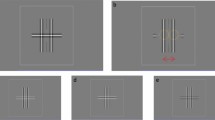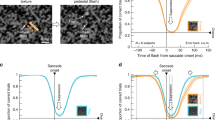Abstract
THE visual system can be described usefully as a hierarchical series of functional stages, the initial stage being physical impingement of the stimulus and the terminal stage being visual perception. Psychophysical investigations typically provide rigorous specification of the first and last stages in the sequence, but a more complete explanation clearly must include information about intermediate stages as well. At present, however, very few techniques are available for analysing inferentially the intermediate stages1. By incorporating two separate phenomena, binocular rivalry and visual aftereffects, into one paradigm, we describe here another technique for inferential analysis of the stages leading to vision. This technique indicates the sequence of stages underlying both phenomena.
This is a preview of subscription content, access via your institution
Access options
Subscribe to this journal
Receive 51 print issues and online access
$199.00 per year
only $3.90 per issue
Buy this article
- Purchase on Springer Link
- Instant access to full article PDF
Prices may be subject to local taxes which are calculated during checkout
Similar content being viewed by others
References
Julesz, B., Foundations of cyclopean perception (University of Chicago Press, Chicago, 1971).
Breese, B. B., Psychol. Monogr., 3, No. 11 (1899).
Fox, R., and Check, R., J. exp. Psychol., 78, 388–395 (1968).
Lack, L., Percept. Psychophys., 13, 374–378 (1973).
Blake, R., and Fox, R., Vision Res (in the press).
Lansing, R. W., Science, 146, 1325–1327 (1964).
McKay, D. M., Nature, 217, 81–83 (1968).
Wohlgemuth, A., Br. J. Psychol, Monogr. No. 1 (1911).
Gibson, J. J., J. exp. Psychol., 16, 1–13 (1933).
McCollough, C., Science, 149, 1115–1116 (1965).
Blakemore, C., and Campbell, F. W., J. Physiol. Lond., 203, 237–260 (1969).
Blakemore, C., and Sutton, P., Science, 166, 245–247 (1969).
Campbell, F. W., and Green, D. G., J. Physiol Lond., 181, 576–593 (1965).
Blake, R., and Fox, R., Nature new Biol., 240, 76–77 (1972).
Author information
Authors and Affiliations
Rights and permissions
About this article
Cite this article
BLAKE, R., FOX, R. Adaptation to invisible gratings and the site of binocular rivalry suppression. Nature 249, 488–490 (1974). https://doi.org/10.1038/249488a0
Received:
Revised:
Issue Date:
DOI: https://doi.org/10.1038/249488a0
This article is cited by
-
Ensemble perception without phenomenal awareness of elements
Scientific Reports (2022)
-
Ring models of binocular rivalry and fusion
Journal of Computational Neuroscience (2020)
-
Binocular Rivalry: A Window into Cortical Competition and Suppression
Journal of the Indian Institute of Science (2017)
-
Congruent tactile stimulation reduces the strength of visual suppression during binocular rivalry
Scientific Reports (2015)
-
Continuous flash suppression reduces negative afterimages
Nature Neuroscience (2005)
Comments
By submitting a comment you agree to abide by our Terms and Community Guidelines. If you find something abusive or that does not comply with our terms or guidelines please flag it as inappropriate.



